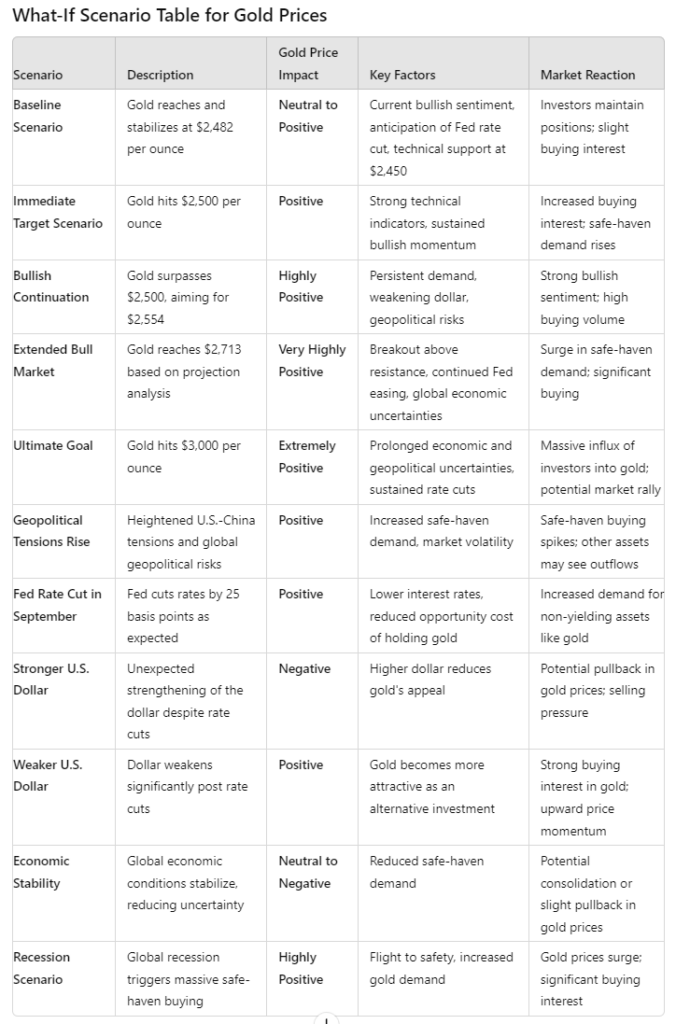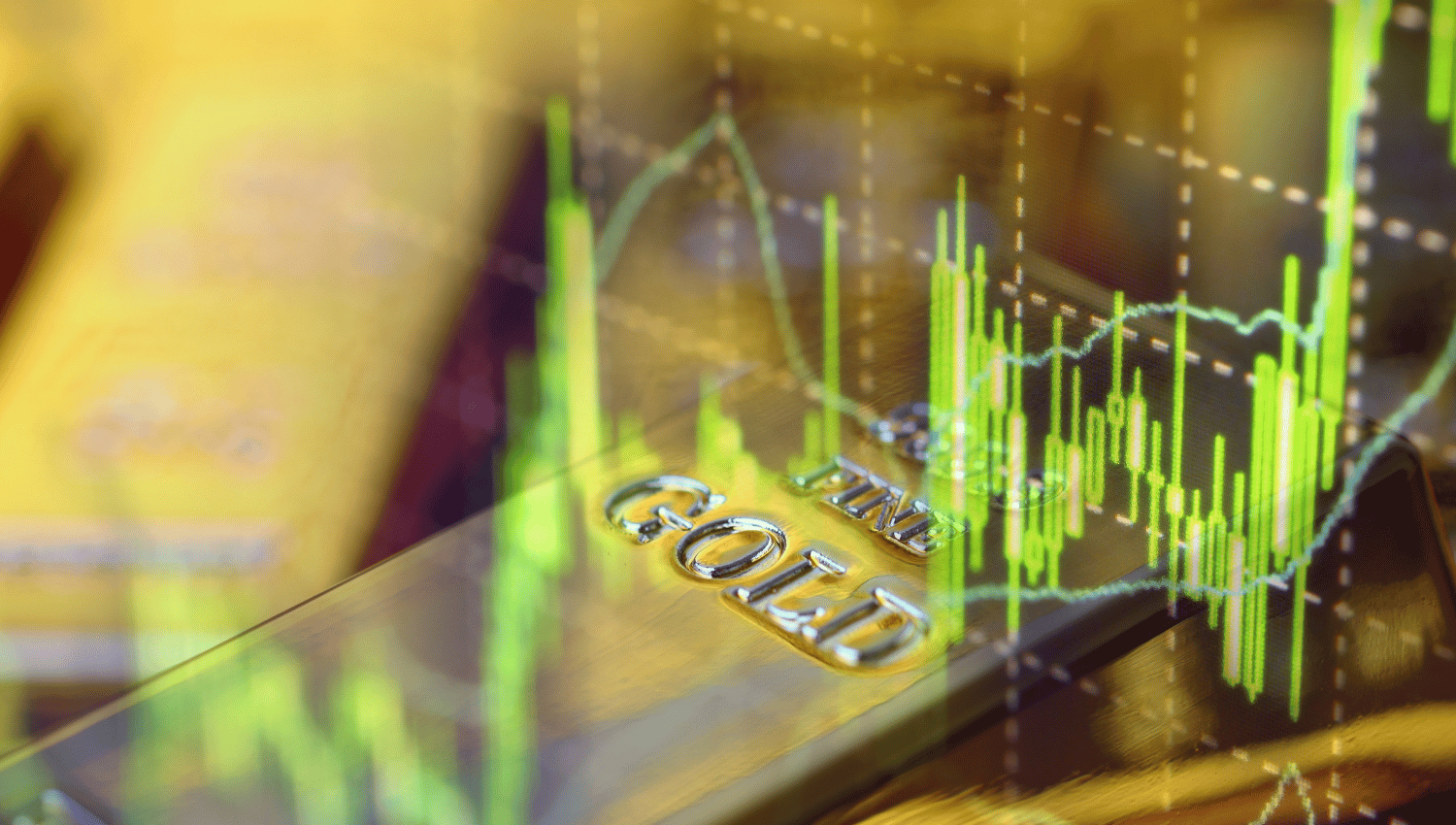Gold has seen an unprecedented rise, hitting a new record high of $2,482 per ounce in July. With the next immediate target set at $2,500 and bullish sentiment fueled by several market factors, traders are eyeing further gains. This article delves into the factors driving this surge, the historical context of Federal Reserve easing cycles, and the broader economic landscape that supports gold’s bullish outlook.
Current Market Scenario
Gold’s meteoric rise has been primarily driven by the anticipation of a U.S. interest rate cut. Spot gold recently stabilized at $2,466.02 per ounce, after reaching the record peak of $2,482.29. U.S. gold futures also gained marginally, standing at $2,470.20. Market analysts are optimistic about gold’s future, with Tim Waterer from KCM Trade highlighting the $2,500 range as the next immediate target.
Factors Driving Gold’s Surge
-
Bullish Technical Indicators: Technical analysis supports a continued rise in gold prices, with projections suggesting a target of $2,508 and potentially higher levels based on wave analysis.
-
Federal Reserve Easing Cycle: Historical data shows that the U.S. dollar often reacts to Fed policy changes with a lag. Kit Juckes from Societe Generale notes that significant dollar declines followed easing cycles in the mid-1980s and early 2000s. The current easing cycle, expected to begin with a 25 basis points rate cut in September, is anticipated to weaken the dollar, thereby boosting gold.
-
Geopolitical and Economic Uncertainties: Global geopolitical risks, particularly surrounding U.S.-China relations and the upcoming U.S. elections, are driving safe-haven demand for gold. Additionally, ongoing geopolitical tensions and economic uncertainties continue to support gold’s allure.
-
Yen Appreciation and Carry Trades: A rising yen poses a threat to carry trades, further increasing gold’s attractiveness as a safe-haven asset.
Historical Context and Fed Easing Cycles
Understanding past Federal Reserve easing cycles provides insight into potential future trends. Since 1984, there have been seven tightening cycles and six easing cycles, each impacting the dollar differently. For instance, during the 1984-1986 easing cycle, the dollar peaked after significant rate cuts. Similarly, the 1989-1994 cycle saw the dollar peak shortly after the first rate cut.
The 1994/95 tightening cycle was followed by rate cuts in 1995/96, with the dollar continuing to rise until 1998. Conversely, the easing cycle starting in 2007 led to a prolonged dollar decline. The most recent easing cycle began in July 2019, with the dollar falling after initial rate hikes, spiking during the COVID-19 pandemic, and then declining again post-pandemic interventions.
Juckes concludes that significant dollar declines often lag Fed easing, although smaller cycles show mixed results. The current outlook suggests a lagged reaction with limited easing unlikely to significantly impact the dollar.
Economic Factors Supporting Gold’s Rise
Several economic indicators bolster the case for continued gold appreciation:
-
Inflation Trends: Recent inflation readings have added confidence that the Federal Reserve’s 2% target is achievable, setting the stage for potential rate cuts. Fed Chair Jerome Powell and Governor Adriana Kugler have expressed cautious optimism about inflation trends, which further supports the case for lower interest rates.
-
Global Interest Rates: As global interest rates are expected to fall, gold benefits from its status as a non-yielding asset. Lower interest rates reduce the opportunity cost of holding gold, enhancing its appeal.
-
Consumer Demand: China, the world’s top gold consumer, maintains strong demand for gold despite pausing official purchases in May and June. This sustained appetite for gold, amid geopolitical tensions and low reserves, supports higher prices.
Market Outlook and Projections
With gold’s current momentum, analysts project several key price targets:
-
Immediate Targets: The next immediate target for gold is $2,500 per ounce. If the current bullish momentum continues, prices could rise further before year-end.
-
Mid-Term Projections: Technical projections suggest potential targets between $2,511 and $2,552, with a rising trendline indicating the possibility of reaching $2,713.
-
Long-Term Goals: The ultimate goal for gold is set at $3,000 per ounce, driven by sustained demand, favorable economic conditions, and geopolitical risks.

Conclusion
Gold’s record surge reflects a confluence of factors including Fed policy expectations, geopolitical uncertainties, and strong technical indicators. As traders position for a lower interest rate environment and safe-haven demand persists, gold is poised to continue its ascent. Historical data and current market dynamics suggest that the precious metal could reach and surpass its next targets, with the ultimate goal of $3,000 per ounce within reach. Investors should closely monitor economic indicators, Fed decisions, and global geopolitical developments to gauge future trends in gold prices.
Disclaimer: This is not an Investment Advice. Investing and trading in currencies involve inherent risks. It’s essential to conduct thorough research and consider your risk tolerance before engaging in any financial activities.



